II Salient points concerning foreigners' entry and stay
Although various changes and trends can be recognized with regard to foreigners' entry and stay, the phenomena that have drawn social attention lately, or that have considerable impacts on the society, are the following.
1. Overall increase in the number of entry and stay of foreigners and main trends in status of residence
In tandem with the progress in the reconstruction of the war-devastated Japan, active international exchanges and the establishment and development of international air routes, the number of foreigners entering Japan has been on the increase almost uninterruptedly from only about 18,000 in 1950 to 1 million in 1978, to 2 million in 1984, and to over 3 million in 1990. (See Figure 1)
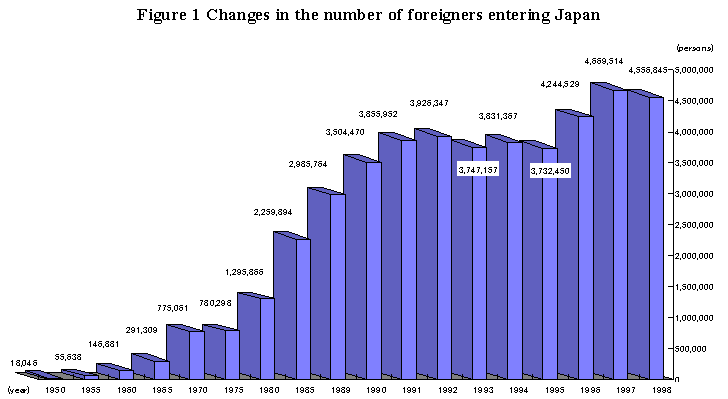
The number of entrants declined in 1995 due to such incidents as the yen's appreciation against other currencies, the Great Hanshin Earthquake and the sarin nerve gas incident. But the number again increased in 1996 to top 4 million and hit an all-time high of 4,669,514 the following year. The number fell slightly in 1998 but still stood at above 4.5 million. The steady increase is one of the phenomena symbolizing the progress in globalization.
Incidentally, the number of Japanese leaving Japan in 1998 was 15,806,218, leaving a huge "net export" of Japanese.
Of the foreigners entering Japan, those for a temporary visit, such as sightseeing, account for more than 90% every year. The rest stay over a medium to long term period, or to "live in Japan," as it were, stands at the 200,000 level. According to statistics on the number of registered foreigners (this includes some of the illegal foreign residents and temporary visitors), the number of foreigners who are "living in Japan" hit a record high of 1,512,116 at the end of 1998, about 2.4 times more than 639,358 posted in 1947, when the alien registration system began. The 1998 figure translates into about 1.2% of the total population of Japan, which stood at about 126.48 million (the estimate published in "Monthly report on Japan statistics" by the Statistics Bureau of the Management and Coordination Agency) in the same year. (See Figure 2)
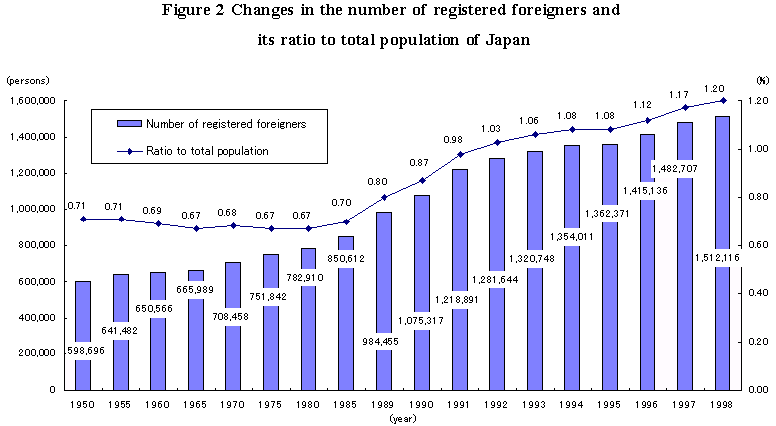
The breakdown of registered foreigners shows that those who are special permanent residents, or mainly of Korean Peninsular origin, account for about 35% of the total, the largest number at 533,396. The ratio of special permanent residents stood at nearly 90% between shortly after the War and the late 1950s. The ratio has declined to less than 40% as a result of an increase in the number of foreigners who came to Japan with various purposes (so-called new comers). This vividly shows changes in situations surrounding foreign residents in Japan.
While fully aware that the situation differs greatly from one country to another, the comparison of the ratio of resident foreigners to total population shows that it is about 19% in Switzerland, about 9% in Germany, about 4% in Britain (all in 1997), and about 5% in the U.S. (in 1990). The ratio in Japan is not high at all among advanced countries. (See Table 1)
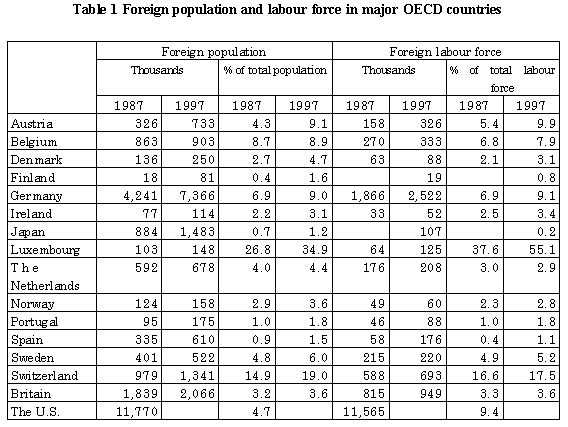
*In the column of foreign population for 1987, the figure for Portugal is that of 1988 and the figure for the U.S. is that of 1990. In the same column for 1997, the figure for Denmark is that of 1997.
In the column of foreign labour force for 1987, the figure for Belgium is for 1986, the figure for Norway is for 1988, the figure for Portugal is for 1988, the figure for Spain is for 1988 and the figure for the U.S. is for 1990. In the same column for 1997, the figure for Denmark is that of 1996.
The figures for the foreign labour force in Japan are the number of foreigners who are under the status of residence for employment.
In the U.S., the figure for the foreign population is the number of the foreign-born population, and the figure for the foreign labour force is the number of the foreign-born labour force. (Compiled from OECD "TRENDS IN INTERNATIONAL MIGRATION 1999 EDITION")
(1) Changes in the foreigners' entry and stay for the purpose of work
There are several angles to look at regarding the changes in the so-called "foreign workers" among foreigners entering and residing in Japan.
The current immigration control system is based on the "Status of Residence," which is classified in accordance with activities to be engaged by foreigners entering and living in Japan and with their status. The number of foreigners entering Japan in 1998 with a status of residence authorized to engage in work (the status of residence in the Annexed Table I-1 and I-2 of the Immigration Control Act, but excluding "Diplomat" and "Official") was 101,891, accounting for about 3% of the new entrants in the year. The number of registered foreigners with a status of residence authorized to engage in work stood at 118,996 at the end of 1998, accounting for about 8% of the total number of registered foreigners. (See Figure 3)
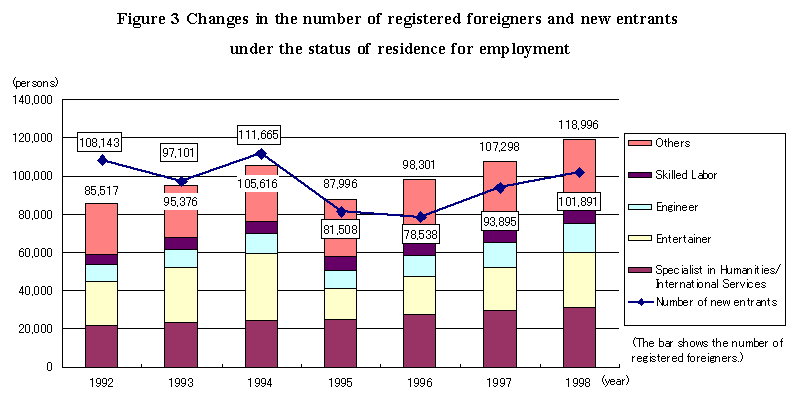
However, the ratio of "foreigners who are authorized to work" would be much bigger if one adds foreigners permitted to engage in work under "Spouse or Child of Japanese National" and "Permanent Resident" (most of them are Japanese descendants), whose scope of activities is not limited. You can also add those who are taking advantage of working holiday system, and students with special permissions to engage in activities other than those permitted under the previously granted status of residence.
Moreover, as will be described later, since many of the illegal residents, whose number is estimated to be at least about 270,000, and other foreigners residing in Japan illegally after illegal entry or illegal landing are believed to be illegal workers, the actual number of "foreigners who are working" is much larger. We can view them as "foreign workers."
It is difficult to get the exact numbers of "foreigners who can work" and "foreigners who are working." However, a general survey of foreign residents in the category of "foreigners who can work" leads us to believe that the number of such foreigners is increasing despite the recent sluggish movement of the Japanese economy.
In particular, the number of foreigners' entry and stay in Japan with a status of residence of "Engineer," "Specialist in Humanities/International Services" or "Intra-Company Transferee," most of them being those employed by business corporations, began to increase in 1997. A breakdown by nationality of foreigners being employed by business corporations shows that those from the U.S. are the largest in number in each category of the status of residence. However, the increases in the number of those from China and India are conspicuous and this gives us some idea of the needs of corporations in Japan. The number of foreigners, including those with other categories of status of residence, has been increasing on the whole with temporary ups and downs. This indicates that the framework that has been set up by the current administration to accept foreigners having technology, skill or knowledge is being made good use of.
(2) A steady increase in the number of trainees and firmly established training and technical internship program
The needs to accept foreigners into Japan for training purposes first arose around the 1960s, when the Japanese economy became internationalized and many corporations began setting up operation bases abroad. Such Japanese corporations began inviting employees of their local subsidiaries or related companies to Japan, hoping that they will acquire relevant skills and technology effectively and that, after returning home, they will play key roles at their companies by using skills and technology acquired in Japan.
Later, in response to requests from industrial circles, the government promoted the expansion and development of the training system conducive to the development of human resources in developing countries not only for the benefit of individual corporations but also from the standpoint of broader international contribution. And the status of residence of "Trainee" and its criteria have been clarified by the Ministry Ordinance that sets the criteria for the revised Immigration Control Act, which went into effect in June 1990, and Article 7-1-2 of the Immigration Control and Refugee Recognition Act (hereinafter to be referred to as "Criteria Ordinance").
In 1993, a technical internship program was established for those foreigners who had acquired a certain level of technology through training so that they can conclude employment contracts with the organization (company, etc.) where they had their training and can put their acquired skill or technology to use and in April 1997, the period of stay for such foreigners was extended.
The number of new entrants into Japan with "Trainee" status of residence was 49,797 in 1998. The number had been falling until 1994 but turned upward thereafter, showing the trend to expand the acceptance of trainees among corporations. (See Figure 4)
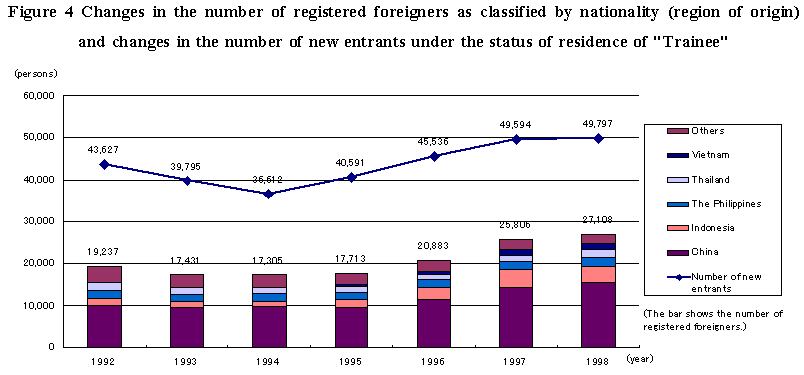
A breakdown of the new entrants by region shows that about 90% come from Asia and, by nationality, China leads the pack with 22,372, or about 47% of the total, followed by, in order, Indonesia, the Philippines, Thailand, and Vietnam.
Meanwhile, the number of technical interns has been increasing steadily since the establishment of the technical internship program in 1993. In 1998, a total of 13,066 trainees changed their status to technical internship, indicating the program has been firmly established in Japan. (See Figure 5)
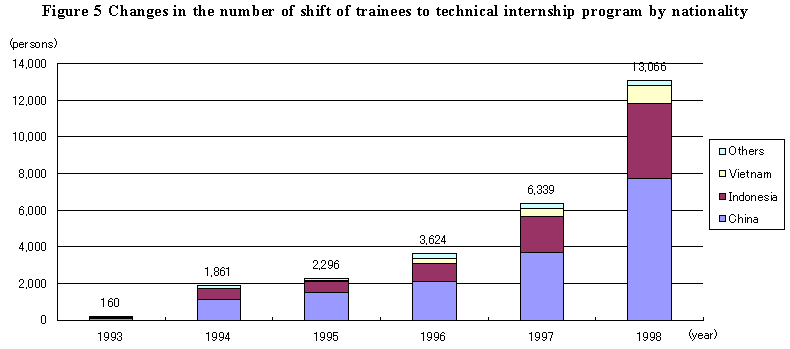
(3) Acceptance situation of college and pre-college students and measures for appropriate acceptance
Acceptance of foreign students to Japan has been promoted actively as a basic policy of the government, particularly since 1983, when the "100,000 Foreign Student Program" was decided.
From the standpoint of immigration control administration, the Ministry of Justice has been striving for active international exchanges of academics and culture through orderly acceptance of college and pre-college students to Japan. The revised Immigration Control Act, which went into effect in 1990, has established a "College Student" status of residence for those who will receive education at universities, colleges or advanced vocational schools (specialized courses at "senshugakko") and a "Pre-college Student" status of residence for those who will receive education at high schools or vocational schools ("kakushugakko") and their criteria have been clarified.
In 1998, the number of new entrants with "College Student" status of residence was 13,478 and that with "Pre-college Student" status of residence was 14,540. (See Figure 6 and Figure 7). A breakdown of "College Student" entrants by nationality shows that China accounted for 4,522, or about 34% of the total, followed by the Republic of Korea and the U.S. and that of "Pre-college Student" entrants shows that China accounted for 6,518, or about 45% of the total, followed by the Republic of Korea and Taiwan.
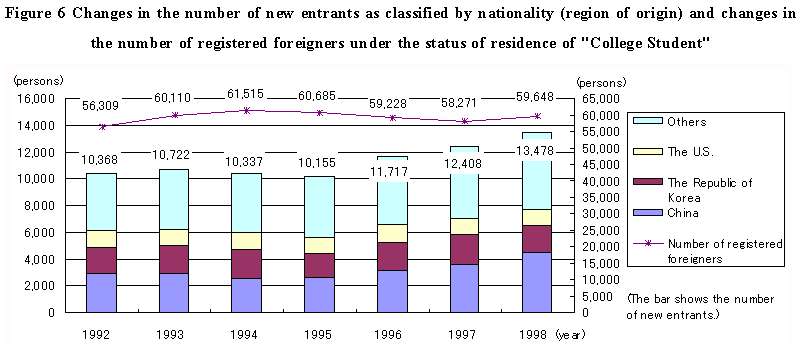
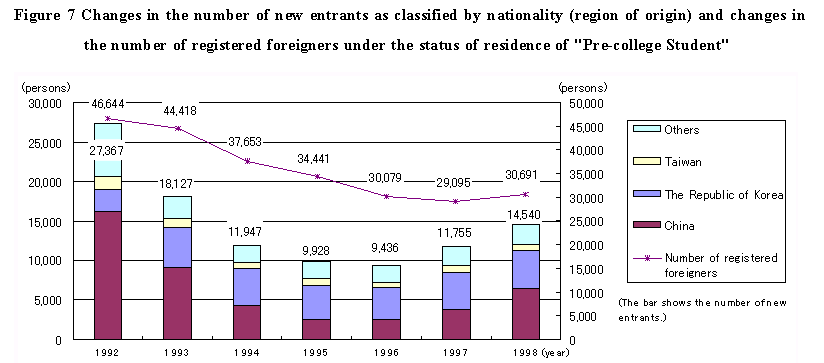
The number of new "College Student" entrants has remained at about 10,000 since it first exceeded 10,000 in 1992. But the number of new "Pre-college Student" entrants decreased by nearly 10,000 to 18,127 in 1993 from 27,367 the previous year and the number continued declining until it turned higher in 1997. In 1998, the number stood at 14,540. The sharp decline in the number of new "Pre-college Student" entrants was mainly due to the stricter immigration inspection implemented to properly cope with a sharp rise in the number of entrants to receive education at Japanese language schools with the purpose of engaging in work. The rises from 1997 onward can be attributed in part to the improvement of management on the part of Japanese language schools.
The number of registered foreigners with "Pre-college Student" status of residence kept declining until 1997. This can be attributed to the deportation of illegal residents who, as was described above, were working illegally under the disguise of student and who were included in the number of registered foreigners.
An increasing number of foreign students choose to get employed in Japan after graduating from university, etc. In this connection, about 2,500 people get their change in the status of residence to, for example, "Engineer" or "Specialist in Humanities/International Services," etc. every year. This phenomenon reflects Japanese corporations' expectation that foreigners, who are well versed in Japanese customs and Japanese way of thinking and who have connections abroad, will play important roles amid the ongoing internationalization of economic activities.
(4) Increase in the number of entry of Japanese descendants and increase in the number of foreigners having close ties with the Japanese society
Of late, a sharp increase in the number of entry of so-called Japanese descendants has become a big social phenomenon. Most of them are entering or residing under the status of residence of "Spouse or Child of Japanese National" or "Long Term Resident." They are being accepted in view of their "ties with the Japanese society" and "their blood relatives with the Japanese society." The "Long Term Resident" status of residence was created in the revised Immigration Control Act that came into effect in 1990. However, the Immigration Control Act does not impose restrictions on activities of foreigners with "Long Term Resident" status of residence. This prompted a large number of Japanese descendants, mainly from South America, to come to Japan accompanied by their family members for the purpose of getting employed without planning to stay for a long term or permanently.
The number of entrants in "Spouse or Child of Japanese National" status of residence has been increasing. This trend proves a rise in the number of international marriages, as well as a rise in the number of entry of Japanese descendants. In 1998, however, the figure fell about 22% from a year earlier to 24,572. In reality, however, there are a considerable number of cases in which foreigners, who got married with Japanese after entry into Japan, change the status of residence to "Spouse or Child of Japanese National." At the end of 1998, the number of registered foreign residents under the status of "Spouse or Child of Japanese National" stood at 264,844 and accounted for about 17.5% of the total number of registered foreigners.
Meanwhile, the number of new entrants under the "Long Term Resident" status of residence stood at 21,501 in 1998, with those from Brazil accounting for about 58%, or 12,543, followed by China, Peru, and the Philippines. The number of new "Long Term Resident" entrants had been in a mild upward trend until 1995, but it surged the following two years, posting a 1.9-fold increase over a year earlier to 12,773 in 1996 and about 2.6-fold increase to 33,353 in 1997, before falling about 38% to 21,501 in 1998. The rise in the number of Brazilian entrants from 1996 onward can be attributed to a temporary effect of the September 1996 change in immigration procedures, which made it possible for Japanese descendants to have a visa issued if they make applications at the Japanese Consulate General in Sao Paulo.
The number of registered foreigners under the "Long Term Resident" status of residence has continued to increase, standing at 211,275 as of the end of 1998. The number of Brazilian came to 115,536, accounting for about 55% of the total, followed by China and Peru in that order. (See Figure 8)
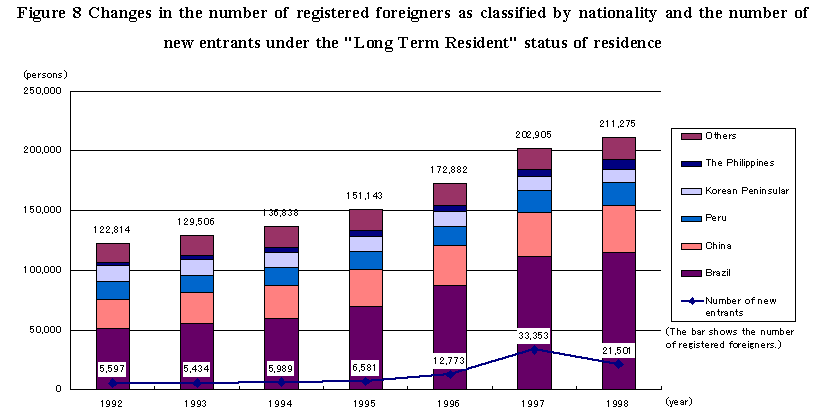
The number of foreigners having "Permanent Resident" status stood at 93,364 at the end of 1998, twice as
much than five years ago. This indicates a steady increase in recent years of "new comer" foreigners having settled in Japan and obtained permanent resident status.
As seen above, many of the foreigners residing in Japan under the status of "Spouse or Child of Japanese National" or "Long Term Resident" appear to have no intention of living in Japan for a long time or permanently. Still, the number of foreigners having "ties with the Japanese society" has been on rising trend and an increasing number are living for a longer term.
2. Trends and problems involved with the Immigration Control Act violators
The number of illegal residents in Japan totaled 268,421 as of July 1, 1999, according to an estimate made by the Immigration Bureau. This represented a decrease of 2,627 (about 1%) from 271,048 as of January 1, 1999, when the previous survey was conducted, and a decrease of 30,225 (about 10.1%) from the all-time high of 298,646 recorded May 1, 1993. This can be partly attributed to the sluggish movement of the Japanese economy in recent years, and also suggests that measures to crack down on illegal foreign workers implemented by the Immigration Bureau in cooperation with other organizations have taken show some effect. Such measures put a brake on the attempts of foreigners to enter and reside in Japan, disguising themselves as tourists, etc. for the purpose of getting employed illegally. Meanwhile, the number of cases is increasing, in which foreigners smuggle themselves into Japan in a group by boat for the purpose of illegally getting employed. The present situation and problems related to illegal residents and other violators of the Immigration Control Act are as follows.
(1) Changes in the number of violators of the Immigration Control Act
Of the total number of illegal residents as of July 1, 1999, the Republic of Korea accounted for the largest number with 63,848, or about 24% of the total, followed by the Philippines, China, Thailand and Peru. Conspicuous in these figures is the decline in the number of illegal residents from Thailand and Malaysia, which accounted for large parts when the number of such residents hit an all-time high on May 1, 1993, and the sharp increase from the Republic of Korea. (See Figure 9)
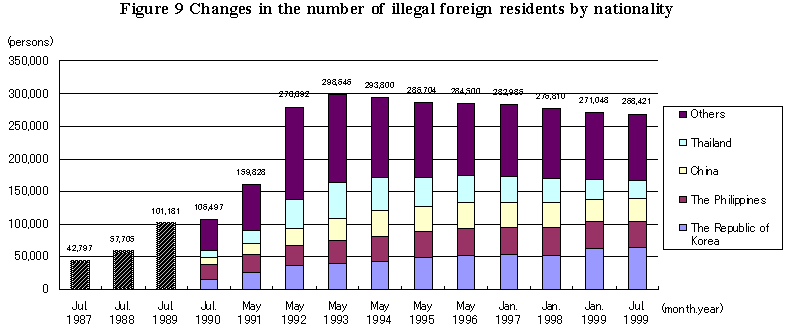
* Nationality-by-nationality figures for the period between July 1987 and July 1989 are not available.
The number of illegal residents whose status of residence was a "Temporary Visitor" at the time of entry was 200,388 and accounted for about 75% of the total, or three out of every four illegal residents entered Japan by disguising themselves as tourists, etc. The ratio of illegal residents who entered through a "Temporary Visitor" status to the total illegal residents has been consistently declining from about 84% as of May 1, 1992. In its place, the number of foreigners entering Japan by disguising themselves as regular visitors through the status other than "Temporary Visitor," such as "Entertainer," has also been on the rise.
Special landing permissions such as Permission for Landing at Port of Call and Permission for Crew Members are systems designed to permit foreigners to land temporarily after going through a simple procedure. But there are cases of misuse, such as overstaying after obtaining permission. Moreover, some foreigners, who entered Japan with a regular status of residence, are engaged in activities other than those permitted under the status of residence, leading us to suspect that there are many foreigners illegally working by repeating entry and stay through the status of "Temporary Visitor."
Among new trend in recent years is a sharp rise, particularly since late 1996, in the number of illegal entrants such as stowaways in a group from neighboring countries like China. Since these foreigners entering illegally into Japan do not go through regular immigration procedures, it is difficult to grasp the actual situation of illegal immigration. However, the number of illegal entrants who were deported by the Immigration Bureau shows that the number of such entrants is on the increase and that they tend to stay longer. The number was relatively small in the mid-1980s, averaging 500 a year. But it began to later increase and stood at 7,472 in 1998 (See Figure 10) and the period of illegal stay became longer. This apparently reflects a rise in the number of groups smuggled by boat and entry by use of elaborately forged passports prepared by transnational criminal organizations for the purpose of getting employed in Japan. This trend could be due to the difficulties for such foreigners to enter Japan through regular landing procedures as a result of a series of measures carried out by the Immigration Bureau, such as strict immigration examination and a temporary suspension of visa exemption measures. With regard to group smuggling, the existence of transnational criminal organizations has become a global problem. Such criminal organizations are engaged in the business of illegally sending people to foreign countries for profit. Their operations have become vicious and shrewd. For example, they have conjured up a close communication system between the sending side and the receiving side to make sure to get payment for smuggling commissions, set up hidden rooms in boats used for smuggling and transfer illegal entrants on ocean fishing boats.
Cases of illegal entry or landing of foreigners aboard airplanes is also increasing. Brokers for forged passports, etc. are also involved in many of these cases.
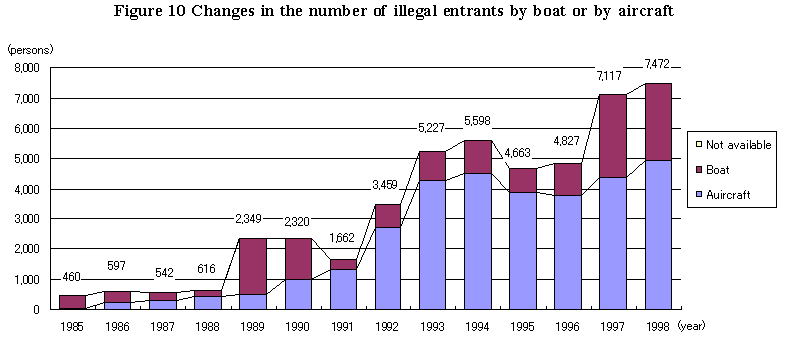
* The number not available is one each in 1987, 1989, and 1990, and two in 1988.
With regard to smuggling brokers, the revised Immigration Control Act of 1997 has established a clause to punish such an act and smuggling is strictly dealt with. But the flow of illegal immigrants into Japan is still continuing.
(2) Characteristics of incidents of Immigration Control Act violation
A Period of stay of illegal workers are getting longer and the number per workplace is getting smaller and spreading to the country
More than 80% of the violators of the Immigration Control Act who were deported were engaged in illegal work and the period of their illegal work has become longer. Several reasons can be sited. Illegal workers have spread to various localities and the number of illegal workers at one workplace has decreased. Therefore the effective crackdown of illegal workers has become difficult, also due to a change in the environment surrounding control, such as a decrease in the amount of information, communicated to the authorities since it is not any more so peculiar to see foreigners in the communities as a result of the increase of foreigners and illegal residents in the Japanese society. It has also become difficult to land in Japan due to stricter landing examinations and it has become difficult to earn a pre-determined amount of money over a short period of time due to smaller income caused by the recession, therefore illegal workers extend the period of stay in Japan to continue illegal work as longer as possible.
B Increase of vicious, shrewd incidents involving organized brokers
The Immigration Bureau has been striving to decrease illegal residents by strengthening landing examinations and positively apprehending illegal entry. However, there has been an increase in the number of incidents such as cases of illegal entry involving the so-called Snake Head, a group of brokers which serves as mediator to smuggle Chinese nationals into Japan. Cases involving brokers of forged visas and Certificate(s) of Alien Registration, cases of disguised Japanese descendants, etc. have increased and the modi operandi have become increasingly vicious and shrewd.
(3) Various problems caused by illegal residents
Since most of the illegal residents are engaged in illegal work, it is threatening to undermine the basis of the Status of Residence System, the pillar of Japan's immigration control administration. Moreover, due to the current severe employment situation, such illegal workers sometimes infringe on Japanese workers' employment opportunity in some industries. Some point out that employers of low-wage earning illegal workers are in an advantageous position over employers of legal workers and that the existence of illegal workers are hampering fair economic competition.
The number of foreigners arrested for criminal offenses (penal offenses, special penal offenses) is on the rise and its adverse impact on safety and order of the Japanese society is expanding. About 60% of the foreigners arrested are those who entered or landed in Japan illegally or those illegally overstaying the authorized period of stay in Japan. Some illegal residents have formed groups bound by blood and through a shared territorial bond to commit organized, heinous crimes, causing frictions with local communities.
There are also cases of human rights violation of foreigners. For example, some illegal workers are exploited by job brokers who charge an exorbitant amount of money for finding jobs for them and some foreigners cannot get worker's compensation or necessary medical treatment due to uncooperative attitude, etc. of the employers.
In addition to the problem of human rights, unpaid medical bills by illegal residents are a serious problem for the employers, medical institutions and local governmental bodies.
